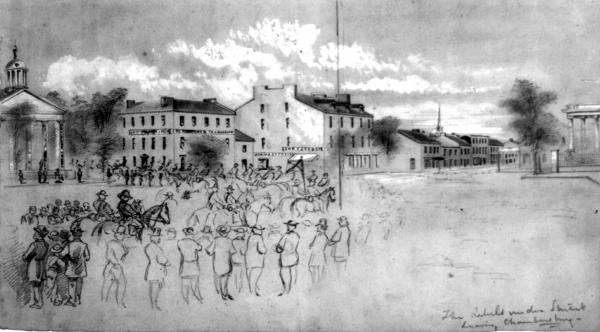 |
| Stuart's troops in Chambersburg (LOC), explorepahistory.com. |
HEADQUARTERS ARMY OF THE POTOMAC,
October 10, 1862-12 p. m.
Captain B. F. FISHER,
Commanding Signal Detachment:
The rebel General Stuart,with about 3,000 cavalry and two batteries took Chambersburg this afternoon, and is now trying to return to Virginia. By daylight to-morrow you will have a party at Williamsport, to communicate with Rowley; one on Washington Monument, to communicate with Spencer, at Hagerstown; one on Catoctin Ridge, west of Frederick, commanding the valleys on both sides for the ridge,and communicating with a point as near as is practicable to this camp. Notify Point of Rocks of the facts. All are to look out and instantly report any force of this nature trying to move across the Potomac Washington Monument reporting to Hagerstown, Rowley reporting to Hagerstown and Williamsport, and stations on Catoctin Ridge reporting near here. Carry out these orders as promptly as possible.
Send a party to assist Rowley and ascertain whether he is taken prisoner, as is possible, the enemy being reported as having crossed at the ford near Fairview. Cox is at Hancock, with his division in railroad cars, and will move by rail the instant he receives information. Officers will return after forty-eight hours, ordered.
By order of Major A. J. Myer:
WM. S. STRYKER,
First Lieutenant and Adjutant, Signal Corps.
Lee wanted to delay McClellan moving forward, knowing the later into the season the more difficult it would be to mount offensive operations. A way to achieve this would be to break the Union supply line between Chambersburg, Pennsylvania and Hagerstown, Maryland. The destruction of the Cumberland Valley railroad bridge at Scotland, five miles from Chambersburg, could accomplish this task. On the 9th Stuart crossed the Potomac west of Williamsport with 1,800 selected troopers and four guns under Pelham. He reached Chambersburg the same night, destroyed a machine shop, and camped in the streets of the town. At daybreak he left, with 500 captured horses, heading back via Emmittsburg and the B&O railroad east of Frederick, recrossing the Potomac near Monocacy on the 12th. Stuart didn't burn the bridge, and it was reported at the time to be constructed of iron. However, other accounts say the 2nd Virginia never made it to the bridge having been told by locals it was made of iron when, in fact, is was of wooden construction. Strengthening this version of the story is the fact that Jenkins, the Confederate cavalry officer, burned the bridge the next year during the Gettysburg campaign. Even though the raid did not achieve its objective, it was a source of great consternation to the Union command and the Lincoln administration, since plans were put in place to disrupt his return, plans which proved as unsuccessful as they had before Richmond.
No comments:
Post a Comment